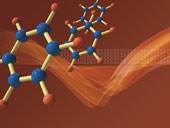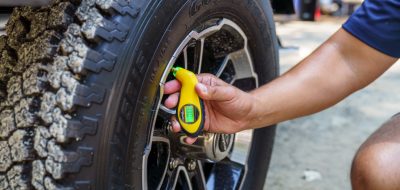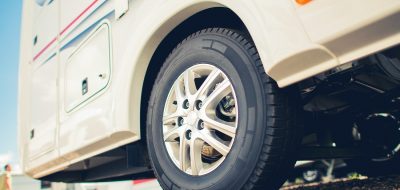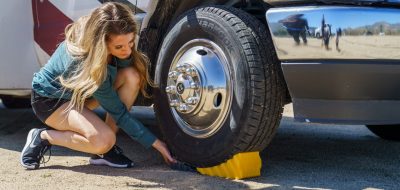 One of the topics that come up often in the RV community is the use of dry nitrogen in tires. That is, using compressed dry nitrogen instead of regular air. Is there an advantage to this that warrants the cost? I think first we have to understand why, and if, nitrogen works better than normal compressed air in an RV tire application.
One of the topics that come up often in the RV community is the use of dry nitrogen in tires. That is, using compressed dry nitrogen instead of regular air. Is there an advantage to this that warrants the cost? I think first we have to understand why, and if, nitrogen works better than normal compressed air in an RV tire application.
Normal dry air contains mainly nitrogen to begin with, in fact about 78% by volume. The balance is around 21% oxygen and 1% argon and mixed miscellaneous gases. Moisture, however, is usually present in this air after it has been compressed. For that purpose, air compressors generally employ a dryer in order to reduce this. But, in normal service station tire fill-ups, you can expect an additional product, vapor or humidity, 1 to 5%. The later being the worst case scenario.
Though we can not see them, the air is made up of molecules. Nitrogen molecules are much larger than those of oxygen. This, in its self, serves as a benefit when used to inflate a tire. More on this later.
Over 99% of tires in use today are tubeless. Tubeless tires expose the rim to the gases that support the tire. Over time these gases and vapor can oxidize or rust the rim surfaces. While such internal damage is slight given the wheel’s life span, it can produce micro metallic pieces or dust. There is a remote possibility that this debris may eventually end up in the tire valve seat. This could occur when air is being expelled such as the quick shot of a tire gauge check or if lowering of pressure is required. I addition, moist air causes oxidization and degradation of the rubber inside the tire. This degradation, however, is slow enough probably to never affect the life of an RV tire.
Have you ever wondered why your tires occasionally need a little air top up? Where does that air go, anyway? It is normal and actually passes through the tire body itself. The smaller molecules of the oxygen make there way out far quicker than the larger nitrogen molecules. Now this does not leak at a measureable rate. Pressure reductions are very subtle, resulting in the need to top up every month or so depending on the tire size, pressure and environment. Using 100% dry nitrogen reduces this leak rate equal to only about one third of that of regular air. This, of course, reduces the need to top up the tire pressure substantially.
Nitrogen also offers the added safety benefit of not supporting combustion. For this reason most aircraft tires are nitrogen filled. This was put in place some years ago following a landing gear fire that was amplified by the oxygen contained in an air filled tire. It contributed to the fatal accident that caused the death of 167 people on board. This feature however, offers little benefit to an RV tire application.
Dry nitrogen does not expand at the same rate of the gases of that of regular air, therefore may tend to increase pressure at a lesser heat to pressure ratio. This in itself, may contribute to a better ride throughout the driving temperature cycle. Additionally, the lack of moisture, or water vapor keeps the gases less conductive to heat transmission, thereby running slightly cooler. A fractional more consistent pressure may be experienced which could result in a smoother, or softer, ride.
Nitrogen is much lighter than air. This would reduce the overall weight to an once or so. Definitely there is no advantage found here for an RV.
Nitrogen fills generally cost about $10 per tire. Costco, for one, supplies a free fill, if requested, with any new tires that are purchased and installed at selected stores. Oh, and yes, you can top up nitrogen filled tires with straight air if needed and no nitrogen is available.
So, is going to nitrogen worth the trouble and cost? In my book it may be very questionable for an RV application. The benefits appear very slim. The reduced tire pressure top up may be well worth it for a commercial unit that runs high mileage twelve months a year. This, however, may offer little change to the short seasonal use of the average recreational vehicle.
Bragging rights can be exercised however. When that guy with the Hemi pulls up beside you at a light, you can say “Nice Hemi, I’m running nitro”.
Okay, I know there are many nitrogen users out there. Let’s hear your take.
Just Airing My Thoughts – Lug_Nut – Peter Mercer








Pingback: sims 4 crack
Pingback: masaza
Pingback: The Unemployed Mom
Lug_Nut
Loader Tires, Glad you enjoyed it. Thank you for your input.
Loader Tires
Another great post. I think this will end up being the start of a great trend in the tire world.
Thanks for the post,
Lug_Nut
Harold DeVries, Great input. Thanks for sharing your experience with us. Certainly a positive statement for nitrogen filled tires.
Harold DeVries
I have driven vehicles with alluminum rims for some time ,I did not expect the corrosion that took place inside the rim .
It became a problem, so much so that it was not abnormal to have to refit the tire after about 15000 km’s.
I still use alluminum rims , but with nitro it looks as if my problems are over .
Harold
Lug_Nut
John Boyd, Some people may refer to the difference as substantial, and it is, given the size we are dealing with and that we are talking about permeation. 3% is a great deal if you are pushing it through a tire body. The 21% oxygen content in an air filled tire passes through the rubber at a rate of 2 to 3 times faster than that of dry nitrogen. This in time, requires topping up. More oxygen is introduced at that time. The difference in leakage of O2 and N2 is quite substantial according to Graham’s Law. Ref: http://www.getnitrogen.org/pdf/graham.pdf
Water in compressed air can be far higher than that of the air present. Accummulation if moisture in service station compressor receivers is quite common. Additionally, this moisture content, once in the tire, accummulates as the need to top up will add still more.
There are variations to all events such as discussed, however the material here is well within a reasonable real life model. Thank you for your questions, interest and input.
John Boyd
I have to challange some of the ‘facts’ you quote in support of nitrogen.
1. Nitrogen molecules are only 3% smaller than oxygen.
2. Where did the 5% of water vapor that you quoted for compressed air from a filling station come from? The water vapor in the compressed air should match the water vapor in the atmosphere, and I don’t think that is normally as high as 5%
3. Since normal air contains 78% Nitrogen, how does changing to pure Nitrogen reduce the leakage rate to 1/3?
Lug_Nut
Warren, You make a very valid point in the comparision of fuel vrs. a nitrogen fill. Thank you for sharing it with us and for your well thought comments.
Warren
My first encounter with nitrogen filled tires was with a brand new Caterpillar front end loader with nitrogen filled tires from the factory.
Caterpillars take was that tires are primarily a petroleum product. There is a potential for petroleum to leach out of the rubber and form an oil residue inside the tire. Now add high pressure compressed “air” and high temperatures from hard use and you have the potential for a tire explosion. Think of what happens inside a diesel engine. Now these tires are huge and one exploding is not something I want to be around.
The theory is that by filling with pure nitrogen you are excluding oxygen and lessening the risk of explosion.
In extreme applications like aircraft tires or the space shuttle or even a front end loader this a very real concern but the small tires, relatively low pressures and temperatures encountered in automotive tires, it is probably a waste of money.
People screamed bloody murder when gasoline went to $3-4 dollars a gallon but thought nothing of spending $1.00 for a pint of bottled water. Spending $15 a tire for nitrogen seems just as silly to me.
Lug_Nut
John, Yes there seems to be a split camp on this topic. Basically it is the difference of having 22% more nitrogen and near zero moisture compared to a straight air fill. The cost is one factor, perhaps the least. The hassle and possible inconvenience is probably the biggest issue.
The issues experienced by mr_whit and Sandra are a real puzzler. It just sounds to me like the problems that can come from flat towing. I towed a Honda S-2000 for about 10,000 miles. The vehicle was brand new and I never got 3,000 miles on the speedo in two years. The tires feathered and I had to replace them at $1600. This was totally a result of flat towing. Thanks John for your valued input on this subject.
Lug_Nut
Sandra, When you say flaking, do you mean feathering? I am presuming that is what you are referring to. Feathering can be caused if you flat tow and don’t rotate your tires, and even sometimes when you do. I don’t believe that dry nitrogen would have any such affect to a tire. I would guess that this is just a coincidence, but interested if any other readers have any input on this. Thanks for sharing this with us and your input.
John
Hi Lug_Nut,
Wow! This is a tough one. I’ve heard of nitrogen use before but, in all my years trucking I always used air. Didn’t have much problem with tires blowing but, then again, I would regularly check tire pressures. Can’t see and economic value in that situation especially when you get upto to 32 tires to fill but then again we’re talking motorhomes here with 8 tires.
Still not convinced of nitrogen use over air. Good point made by Dan in tire sales.
Wonder if other gasses may be more beneficial. Such as helium, CO2 etc.
As it stands now, it seems more trendy than functional. As far as air molecules leaking through the tire wall, is there something that can be added when pressurizing the tire that can help seal or at least slowdown the loss of air or nitrogen molecules? Great article! Keeps the brain cells active.
Hope more nitrogen users will add their comments, we’ll be watching for ’em.
Cheers,
John
Sandra
I have a 2007 Subaru with 35,000 miles and the nitrogen filled tires are flaking on the sides. We have always gotten 80,000 miles out of our tires and this is really disappointing. We live in the same area, drive the same distances, so I can only conclude that it is the nitrogen. We are replacing these with a new air filled set.
Sandra
I have a 2007 Subaru with 35,000 miles and the nitrogen filled tires are flaking on the sides. We have always gotten 80,000 miles out of our tires and this is really disappointing. We live in the same area, drive the same distances, so I can only conclude that it is the nitrogen. We are replacing these with a new air filled set.
Lug_Nut
r charlie, Yes leakage will happen also with nitrogen filled tires, albeit at a rate near 1/3 to 1/2 of that of straight compressed air. You may also be correct, it may well be a total waste of time. The word “Time” refers to the bother portion of the question. Thank you for your somewhat expert opinion on this topic, and of course, your very valued input.
r charlie w
Nitrogen in tires is a waste of time. The tires are porous at the molecular level. The interior air will eventually mimic the exterior air including moisture. The same way a ballon loses air. I work with many scientists, mostly Chemical Engineers. None that I have asked would recommend you go out of your way to get nitrogen.
Lug_Nut
Dan, Wow! I think I know which side you are on. You do, however, make a great point. If I keep my RV under 150 MPH I may not ever need to consider filling my tires with nitrogen. I too, am leaning in your direction. Thanks for the honest input.
Lug_Nut
Gordon Thompson, Good to hear from a user and a supporter of using nitrogen in RV tires. You are right, it is peanuts extra. I guess the real issue is dealing with the bother. Many people today do not want the bother. I see both sides, and in many whys support both. Thank you for your participation and valued input.
Lug_Nut
BART, Great input for those that do not support the use of nitrogen in RV tires. I tend to agree, at least in my experience that the bother and cost may not out weigh the benefits. Thanks for the input on this topic.
Lug_Nut
Arliss C. Weber, Thank you for bringing other possible causes of mr_whit’s issue to the forefront. The fact that this occurred after changing the tires, may well account for other factors including wheel mis-alignment. Thank you for your input.
Lug_Nut
mr_whit, No I do not believe the difference of air (78% nitrogen) or 100% dry nitrogen would have any bearing on your issue, subject to both being of similar cold pressure. The type of tire wear you described may well be caused by other factors such as tire application type and like differences. Thank you for sharing your experience with nitrogen filled tires and your input.
dan
I ‘m in wheels and rims sales for over 20 years .I deal with tirer shops and I sale nItrogren machine and air compressor , air tools.
So if you drive the space shuttle ,F18 ,commercial plane ,stealth etc… then nitrogen will be a asset to you .
Other wise your wasting your money .
For over the road nascar or indy cars is good for them .
If you have money to waste maybe you should give it to a charity.
All that to say for car ,pickup etc…it is a market skeem
take care RVER
DAN
Gordon Thompson
We have been through this before on another blog but my take hasn’t changed after all the arguments. Let’s start by assuming that we should discount all the positive hype about the use of nitrogen by half. I’m a full timer that paid somewhere close to $150k for my truck and fiver. Add a few dollars for the contents which is all I own and a few pennies for our hides and that adds up 🙂
It cost me less than $50 to put nitrogen in seven tires for the truck and another $30 for the five tires on the fifth wheel. That’s about two nights in a decent park and I’m on the road between my summer and winter bases for about 5000 miles a year hoping to keep the rubber side down all the time.
The only inconvenience is in topping up which I choose to do with compressed CO2 between major service stops. The total cost of nitrogen works out to peanuts when I use my perspective. To me it’s a no brainer and the decision adds a bit to my store of peace of mind which is good enough for me.
BART HAFFERKAMP
iam one of those people who injoy doing my own mechanical work.i don”t think i would spend the money on nitrogen.how much work is there in checking your tire”s my wife and i own 25′ toy hauler for our motorcycle sidecar rig.i have a onboard aircompresser . we live in wisconsin so heat is not a problem. anyway checking your tire”s is a good way of seeing other problems.no i would not bother. thank you BART.
Arliss C. Weber
mr_whit
I may be way off base, but that sounds like a problem I had 10 plus years ago. One axel was not running true, in fact just under a inch out of alingement form the other drum, but that inch sure wore the tires out fast.
It could also be the rims were not tourqued properly leaving them a little out of alingement. This may be true of the tires as well.
This is just a guess and my 2 cents worth.
Good Luck
mr_whit
Hi Lug-nut, question please… I have a 3500 4X4 pulling a 16,000# 5th wheel…my orginal tires were Michelin 10 ply A/S filled with air. 50,000 miles later they finaly wore out
…I changed to Michelin 10 ply LTX A/T with nitro. At 5,000 miles all 4 tires have “feathered” and tread depth has woren 30%.
…the Costo sales man said the LTX will last 50-60,000 miles when I was shopping for tires.
Do you think the nitro has lead to the excess wear?-whit